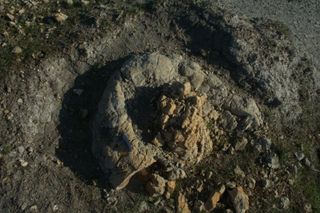
First Fossil Whale Poop Pops Up in Italy

Clumps of squid beaks sticking out of clay in Italy's Umbrian badlands may be the first fossilized ambergris, or whale poo, ever found.
Ambergris is a fatty, waxy-looking substance. Scientists believe sperm whales — the largest toothed predator on Earth — secrete ambergris inside their digestive tracts to protect themselves from sharp objects, like giant squid beaks and fish bones and teeth. And contrary to urban legend, ambergris is actually whale poo, not vomit. Sought after by perfume makers, aged ambergris is like umami for the nose, adding musky depth to scents.
Even though scientists have discovered fossilized feces, called coprolites, from dinosaurs, ichthyosaurs, mammoths and sharks, no one has reported finding ancient ambergris.
"These structures, derived from the original fossil ambergris masses, represent the first recovery on a global scale, since nothing like [it] has been described before in the scientific literature," lead study author Angela Baldanza, a sedimentary geologist at the University of Perugia in Italy, said in an email interview.
Baldanza and her colleagues discovered the fossil ambergris in September 2011, while surveying the remains of a Pleistocene ocean in southwestern Umbria in central Italy. The region is well known for sperm whale fossils, though few have been found near the site of the fossil ambergris, Baldanza said. [Image Gallery: Fantastic Fossils]
Trekking across the badlands, the scientists noticed mineralized lumps sticking out of the 1.75-million-year-old rocks. They found 25 of the rounded structures over an area of about 0.3 acres (1,200 square meters). Each was about 23 to 47 inches (60 to 120 centimeters) wide and 12 to 23 inches (30 to 60 cm) long. The mounds were circular or tapered.
"The preliminary observations revealed they were of biological origin, but bore no resemblance to any known trace fossil," Baldanza told LiveScience's OurAmazingPlanet. "From the first moment we discovered them, these structures looked enigmatic."
Sign up for the Live Science daily newsletter now
Get the world’s most fascinating discoveries delivered straight to your inbox.
Several clues led the researchers to conclude they had found fossil whale poo. The trace fossils were striated with concentric rings, like modern ambergris, and their rounded and tapered shapes matched the appearance of ambergris found in sperm whales killed on ships in the 1950s. Squid beaks and altered organic matter in the fossils also hinted at an origin in a sperm whale's stomach.
A chemical analysis of the rocks revealed traces of organic molecules from squid beaks and mammalian digestive tracts. "Unfortunately, chemical analyses are not conclusive, but preliminary results support the hypothesis," Baldanza said.
The cluster of coprolites in a relatively small area led the researchers to speculate that a mass whale die-off may have deposited the ambergris, Baldanza said. The bodies decomposed, but the ambergris remained.
"We are investigating the causes of such accumulation in a restricted area," Baldanza said.
Email Becky Oskin or follow her @beckyoskin. Follow us @OAPlanet, Facebook & Google+. Original article on LiveScience's OurAmazingPlanet.

Most Popular



